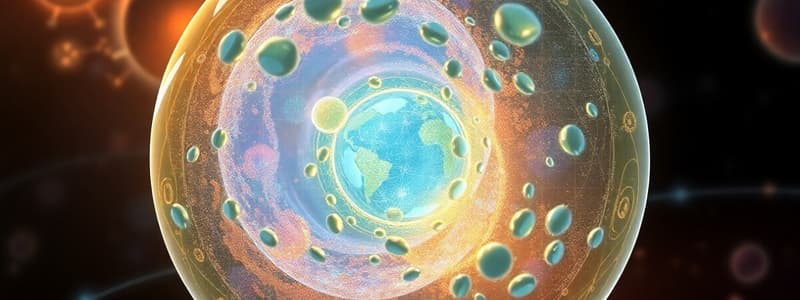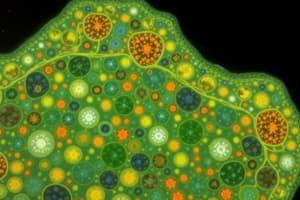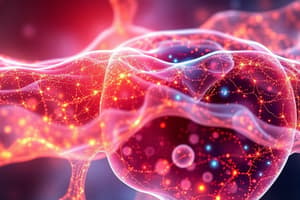Podcast
Questions and Answers
What is the primary function of the plasma membrane?
What is the primary function of the plasma membrane?
- To define the cell's boundaries and separate fluid compartments. (correct)
- To embed peripheral proteins within the lipid bilayer.
- To synthesize glycolipids for cellular processes.
- To facilitate the transport of water-soluble molecules.
According to the fluid mosaic model, what is the basic structure of the plasma membrane?
According to the fluid mosaic model, what is the basic structure of the plasma membrane?
- A single layer of glycolipids with integral proteins.
- A bilayer of lipid molecules with embedded proteins. (correct)
- A single layer of phospholipids with interspersed proteins.
- A double layer of proteins with lipids embedded within.
What characteristic of phospholipid tails causes them to align in the center of the membrane?
What characteristic of phospholipid tails causes them to align in the center of the membrane?
- Their interaction with cholesterol.
- Their polar nature.
- Their attraction to water.
- Their nonpolar properties, avoiding water. (correct)
What is the role of cholesterol in the plasma membrane?
What is the role of cholesterol in the plasma membrane?
How do integral proteins differ from peripheral proteins in the plasma membrane?
How do integral proteins differ from peripheral proteins in the plasma membrane?
What are transmembrane proteins?
What are transmembrane proteins?
Which of these options are attached to lipid molecules on the outer surface of the plasma membrane, forming glycolipids?
Which of these options are attached to lipid molecules on the outer surface of the plasma membrane, forming glycolipids?
What makes the phospholipid heads polar?
What makes the phospholipid heads polar?
What primary role is served by the network of filaments associated with peripheral proteins that reside on the cytoplasmic side of the plasma membrane?
What primary role is served by the network of filaments associated with peripheral proteins that reside on the cytoplasmic side of the plasma membrane?
What is the name of the ‘sugar coating’ found on cell surfaces, created by short carbohydrate chains attached to integral proteins and lipids?
What is the name of the ‘sugar coating’ found on cell surfaces, created by short carbohydrate chains attached to integral proteins and lipids?
What role do the sugars of a cell's glycocalyx play in cellular interactions?
What role do the sugars of a cell's glycocalyx play in cellular interactions?
Which of the following is NOT a primary function of the plasma membrane?
Which of the following is NOT a primary function of the plasma membrane?
How do membrane receptors facilitate cellular communication?
How do membrane receptors facilitate cellular communication?
What is a key property of the plasma membrane that determines which substances can cross it?
What is a key property of the plasma membrane that determines which substances can cross it?
What type of molecules can move passively across the plasma membrane via simple diffusion?
What type of molecules can move passively across the plasma membrane via simple diffusion?
What is the term used to describe the diffusion of water molecules across a membrane?
What is the term used to describe the diffusion of water molecules across a membrane?
When substances move via facilitated diffusion, how do they travel through the plasma membrane?
When substances move via facilitated diffusion, how do they travel through the plasma membrane?
What distinguishes active transport from both simple and facilitated diffusion?
What distinguishes active transport from both simple and facilitated diffusion?
Flashcards
Peripheral Proteins
Peripheral Proteins
A network of filaments on the cytoplasmic side of the plasma membrane that provides structural support.
Glycoproteins
Glycoproteins
Short carbohydrate chains attached to integral proteins, projecting from the external cell surface.
Glycocalyx
Glycocalyx
The sugar covering that surrounds a cell, formed by glycoproteins and glycolipids.
Selective Permeability
Selective Permeability
Signup and view all the flashcards
Simple Diffusion
Simple Diffusion
Signup and view all the flashcards
Osmosis
Osmosis
Signup and view all the flashcards
Facilitated Diffusion
Facilitated Diffusion
Signup and view all the flashcards
Active Transport
Active Transport
Signup and view all the flashcards
Membrane Receptors
Membrane Receptors
Signup and view all the flashcards
Cellular Communication
Cellular Communication
Signup and view all the flashcards
Plasma Membrane
Plasma Membrane
Signup and view all the flashcards
Fluid Mosaic Model
Fluid Mosaic Model
Signup and view all the flashcards
Phospholipid
Phospholipid
Signup and view all the flashcards
Glycolipids
Glycolipids
Signup and view all the flashcards
Cholesterol
Cholesterol
Signup and view all the flashcards
Integral Proteins
Integral Proteins
Signup and view all the flashcards
Transmembrane Proteins
Transmembrane Proteins
Signup and view all the flashcards
Study Notes
Plasma Membrane Structure
- The plasma membrane, also called the plasmalemma, is a thin, flexible layer surrounding a cell.
- It separates intracellular fluid (inside the cell) from extracellular fluid (outside the cell).
- It acts like a security fence, controlling what enters and leaves the cell.
Fluid Mosaic Model
- The plasma membrane is a phospholipid bilayer with embedded proteins.
- Phospholipids have a polar head (attracted to water) and nonpolar tails (repelled by water).
- These arrange in two layers, with heads facing outward and tails inward.
- The membrane also contains cholesterol, which increases rigidity and impermeability to water-soluble substances.
- Glycolipids—phospholipids with attached sugar groups—occur on the exterior surface.
Membrane Proteins
- Integral proteins are embedded within the lipid bilayer.
- Some integral proteins are transmembrane proteins, spanning the entire membrane.
- Peripheral proteins are loosely attached to the membrane surface, often forming a support network on the cytoplasmic side.
- Some proteins have attached carbohydrate chains.
Glycocalyx
- The glycocalyx is a sugar coat made of glycoproteins and glycolipids on the outer cell surface.
- It acts as a sticky layer, aiding cell adhesion and recognition.
- The unique sugar patterns on the glycocalyx help identify different cell types (e.g., sperm recognizing an egg).
Plasma Membrane Functions
- The plasma membrane acts as a protective barrier.
- Membrane proteins act as receptors, binding to external molecules and triggering cellular responses.
- The membrane controls which substances enter and leave the cell.
Membrane Transport
- Small, uncharged molecules (e.g., oxygen, carbon dioxide) can cross the membrane by simple diffusion (moving from high to low concentration).
- Water diffuses across the membrane through osmosis.
- Larger, charged, or water-soluble molecules need specific transport mechanisms (integral proteins).
- Facilitated diffusion involves movement down the concentration gradient, assisted by transport proteins.
- Active transport moves molecules against their concentration gradient, requiring energy.
Studying That Suits You
Use AI to generate personalized quizzes and flashcards to suit your learning preferences.




